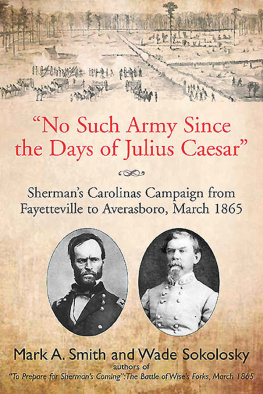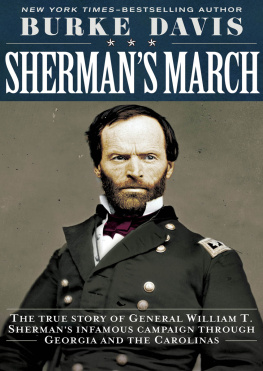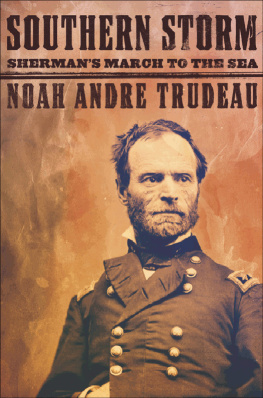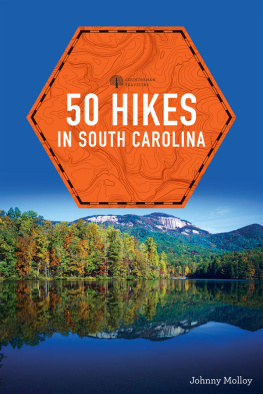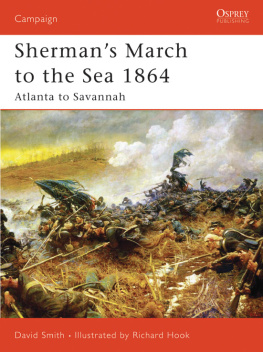F ACING
S HERMAN
IN S OUTH C AROLINA
F ACING
S HERMAN
IN S OUTH C AROLINA
M ARCH T HROUGH THE S WAMPS
SERIES EDITOR
DOUGLAS W. BOSTICK
C HRISTOPHER G. C RABB

Published by The History Press
Charleston, SC 29403
www.historypress.net
Copyright 2010 by Christopher G. Crabb
All rights reserved
Front cover: War is Hell by Mort Knstler.
2003 Mort Knstler, Inc. www.mkunstler.com
First published 2010
e-book edition 2011
ISBN 978.1.61423.064.9
Library of Congress Cataloging-in-Publication Data
Crabb, Christopher G.
Facing Sherman in South Carolina : march through the swamps / Christopher G. Crabb.
p. cm.
Includes bibliographical references and index.
print edition: ISBN 978-1-60949-015-7
1. Shermans March through the Carolinas. 2. Shemans March through the Carolinas--Personal narratives. 3. Sherman, William T. (William Tecumseh), 1820-1891. 4. South Carolina--History--Civil War, 1861-1865--Campaigns. 5. Swamps--South Carolina--History--19th century. 6. Rivers--South Carolina--History--19th century. 7. South Carolina--History--Civil War, 1861-1865--Personal narratives. 8. United States--History--Civil War, 1861-1865--Campaigns. 9. United States--History--Civil War, 1861-1865--Personal narratives. I. Title.
E477.7.C73 2010
975.703--dc22
2010043168
Notice: The information in this book is true and complete to the best of our knowledge. It is offered without guarantee on the part of the author or The History Press. The author and The History Press disclaim all liability in connection with the use of this book.
All rights reserved. No part of this book may be reproduced or transmitted in any form whatsoever without prior written permission from the publisher except in the case of brief quotations embodied in critical articles and reviews.
Contents
Chapter 1
Will They Invade UsWhere Is Their Army?
That army of vengeance had arrived. It was men of the Left Wing of Major General William Tecumseh Shermans 65,000-man gargantuan that had the distinction of being the first on South Carolina soil in an invasion many had hoped for the entire war. Ever since the perceived insult to the national colors that came with the firing on Fort Sumter, a collective mood of vengeance against the Palmetto State found its way into the minds of many men in blue. Longingly they dreamed of the day an army would march through South Carolina and punish that entity once remarked to be too small to be a country, too large to be an insane asylum.
The redemption of a nations sacred honor demanded such retribution in the minds of western boys from Illinois, Indiana, Wisconsin, Michigan, Ohio, Iowa and Minnesota. Eastern lads from Pennsylvania, New York, New Jersey, Connecticut and Massachusetts may have longingly dreamed of invading the state that in their minds instigated the fall of dominoes that led to the slaughter of their comrades at Chancellorsville, Gettysburg and Fredericksburg. In lockstep with these boys from north of the Mason-Dixon were men from border states Missouri and Kentucky, laying aside family and fraternity ties to follow Uncle Billy.
Now the opportunity for this punitive invasion designed to cripple the Southern war effort had finally come. These veterans from all over the Union could now lock horns with the sons of the chivalry, the best and the brightest of the state that aimed the first cannon in Charleston in the spring of 1861. But another enemy lay ahead, an enemy that couldnt be driven away with superior numbers: the South Carolina landscape. Rather than the sons of the Palmetto State, they would face a diversity of displaced Confederates holding endless myriad swamps, creeks and watercourses. It would take a special kind of army to cross through South Carolina, as this was no ordinary campaign. What kind of army that would be remained to be seen.
On December 30, 1864, Major General William Ward waited with his Third Division of the Twentieth Army Corps to cross the Savannah River into South Carolina. Born in Virginia, the Kentucky transplant perhaps would have taken a different path that did not include crossing the swollen Savannah had it not been for a childhood move by his parents. As it has a way of doing, fate now placed Ward along the banks of the Savannah. Like in Charleston harbor four years before, a Kentuckian in blue stared across the water at South Carolina. Starting fresh the next morning, Wards division crossed via a pontoon bridge to Hutchinson Island. The broad river made the island a spot of dry land dividing the river into two channels like a stone resting in the midst of a raging creek. Complications arose as the bridge was not yet complete. A soldiers companion through the agesdelaymarked the invasions first moments.
Fortunately, three small boats made up the difference. Ironically, the largest invading army to ever step foot into South Carolina would first come ashore in small boatloads. Unfortunately, there was still more hurry up and waiting to do. It was the waiting that provided both misery and danger for Federals. Misery came with every ticking second as many of Wards men had not been reoutfitted in Savannah, making the bone-chilling rain nearly unbearable. Danger also made its presence known. Protected by the swollen river, Rebel pickets added to the elements by raining down lead on the waiting Yankees. The fire was accurate enough to keep the hunkering Federals honest by killing a man of the 105th Illinois and wounding another of the 102nd Illinois.
Elements of Colonel Henry Cases First Brigade were the first ashore in South Carolina. Driving off the pickets, the Yankees were now alone. Unfortunately, it would be unlikely that any comrades could be crossed over that night. Since a lodgment is only as safe as the reinforcements it can count on, Cases isolated spear point was withdrawn to Hutchinson Island. The delay was fitting. The crossing into South Carolina would open the new year. Throughout the following day, Cases entire brigade finally crossed the Savannah. Swatting away Rebel scouts, the vanguard pushed to a plantation five miles inland. It was here that their first taste of the reviled South Carolina chivalry would come. Not surprisingly, here the first taste of vengeance against the state would manifest itself.
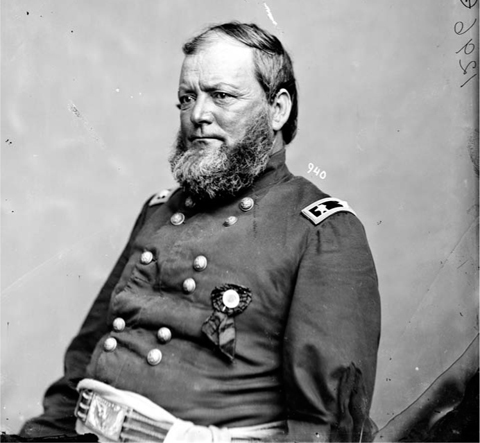
Leading the way: Major General William T. Ward. Courtesy of the Library of Congress.
Predictably, it was quite a cold night for the newly arrived Yankees. According to Stephen Fleharty of the 102nd Illinois, it did not take too much imagination to make their stay more comfortable. After all, they were in South Carolina, a state that hardly endeared itself to Shermans vengeful command. One Union soldier described this callous feeling with his hope that the state should be pretty thoroughly overhauled and that rebellion should soon play out all around. Before long, unoccupied houses and barns were torn down as replacement firewood for nearby wet green pine. Only the owners home, a very large, elaborately furnished, two story gothic mansion, and an overseers home temporarily escaped destruction as Union officers conscripted them into service.
Cases advance inland sent a lightning bolt through the Confederate command. His brigades rapid progress forced Lieutenant General Joseph Wheelers cavalry to watch a very real threat. Wheelers cavalrymen hugged Cases columns gathering intelligence. Unsurprisingly, information was sketchy. Only reports of half-mile-long Federal columns and arriving steamboats offered any clues. Neither report was promising for Confederates screening the Yankee advance.
Next page



